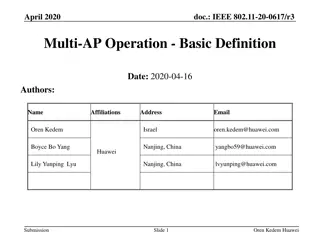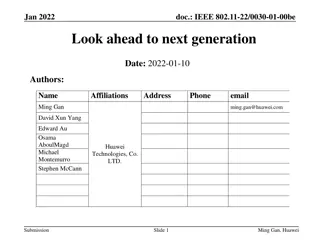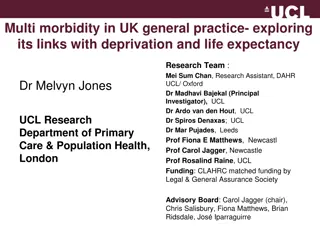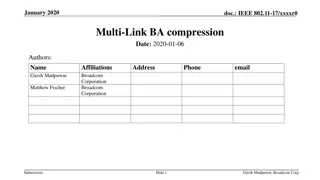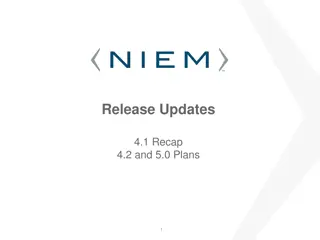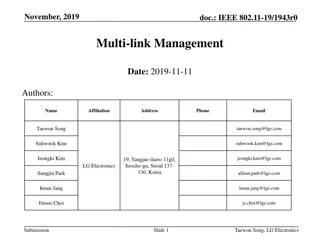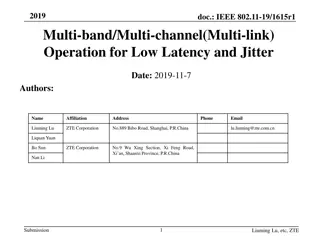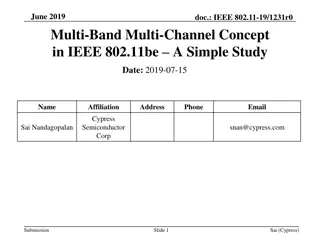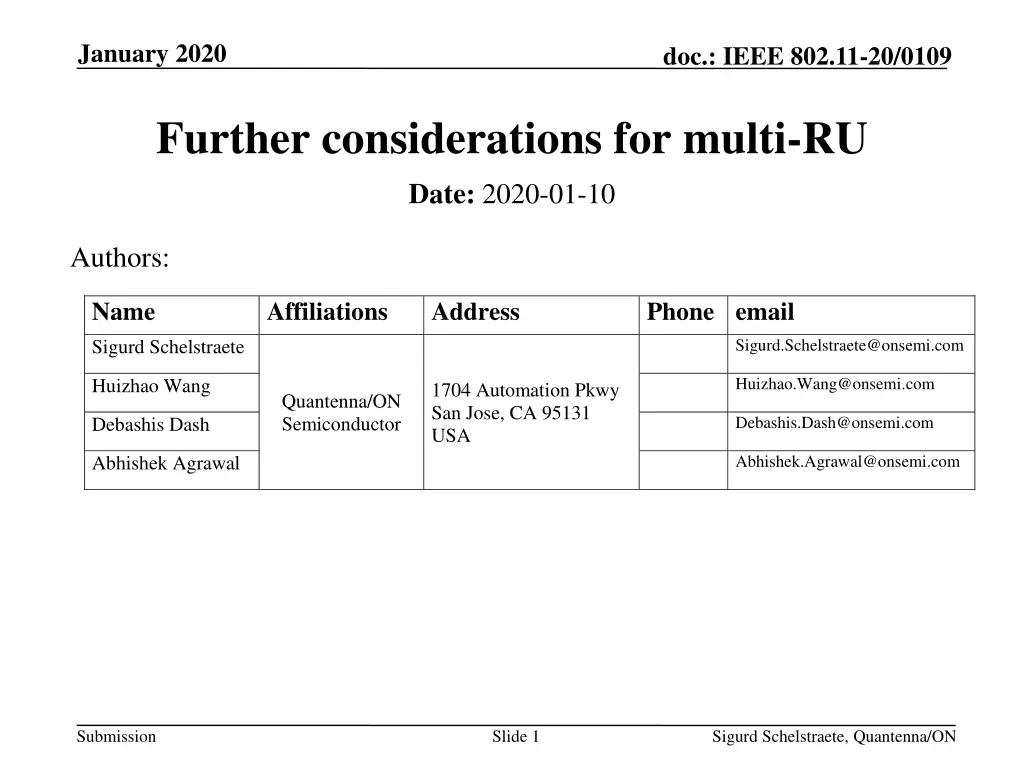
IEEE 802.11-20/0109: Multi-RU Considerations for 11be Standard
Explore the considerations for implementing multiple RUs for a single STA in the IEEE 802.11be standard. Topics include signaling, bit processing, MCS selection, and potential combinations with MU-MIMO technology. Discover how current RU addressing limitations can be overcome and the proposed approaches for efficient multi-RU signaling and bit processing in transmissions.
Uploaded on | 0 Views
Download Presentation

Please find below an Image/Link to download the presentation.
The content on the website is provided AS IS for your information and personal use only. It may not be sold, licensed, or shared on other websites without obtaining consent from the author. If you encounter any issues during the download, it is possible that the publisher has removed the file from their server.
You are allowed to download the files provided on this website for personal or commercial use, subject to the condition that they are used lawfully. All files are the property of their respective owners.
The content on the website is provided AS IS for your information and personal use only. It may not be sold, licensed, or shared on other websites without obtaining consent from the author.
E N D
Presentation Transcript
January 2020 doc.: IEEE 802.11-20/0109 Further considerations for multi-RU Date: 2020-01-10 Authors: Name Sigurd Schelstraete Affiliations Address Phone email Sigurd.Schelstraete@onsemi.com Huizhao.Wang@onsemi.com Huizhao Wang 1704 Automation Pkwy San Jose, CA 95131 USA Quantenna/ON Semiconductor Debashis.Dash@onsemi.com Debashis Dash Abhishek.Agrawal@onsemi.com Abhishek Agrawal Submission Slide 1 Sigurd Schelstraete, Quantenna/ON
January 2020 doc.: IEEE 802.11-20/0109 Introduction It has been agreed in principle to support multiple RUs for a single STA in 11be RU sizes and combinations were discussed in [4] In this submission we additionally consider: Signaling for multi-RU Bit processing and frequency domain processing MCS selection Combination with MU-MIMO Submission Slide 2 Sigurd Schelstraete, Quantenna/ON
January 2020 doc.: IEEE 802.11-20/0109 Multi-RU signaling Current RU addressing in an HE MU PPDU does not allow allocating more than one RU to a single STA (see D6.0, clause 26.5.1.2) Equivalently, all (occupied) user specific fields in HE- SIG-B have a unique STA-ID However in spite of the usage restriction, nothing in the actual format of TXVECTOR or HE-SIG-B precludes using the same STA-ID for multiple RUs E.g. have two user specific fields with the same STA-ID field Submission Slide 3 Sigurd Schelstraete, Quantenna/ON
January 2020 doc.: IEEE 802.11-20/0109 Multi-RU signaling (2) The easiest way is to signal multi-RU appears to be to reuse 11ax TXVECTOR/HE-SIG-B format without the usage restriction No explicit signaling is needed beyond that A receiving STA can recover the needed information from parsing HE-SIG-B and collecting all fields matching its STA-ID NOTE: Receiver can no longer stop processing at the first User Specific field that has a matching STA-ID Not a very onerous requirement STAs not included in an MU transmission already process all user specific fields NOTE: new signaling may still be needed for use of multi- RU in UL OFDMA Submission Slide 4 Sigurd Schelstraete, Quantenna/ON
January 2020 doc.: IEEE 802.11-20/0109 Bit processing for multi-RU transmission In general, we can observe that bit processing (coding/Padding/scrambling, ) is done per user Stream Parsing/interleaving/constellation mapping/tone mapping/pilot insertion for each user is done per RU As also proposed elsewhere, we suggest to stay with this approach for the case of multi-RU transmissions Single encoder per user Coded bits per symbol divided over RUs and processed per RU Submission Slide 5 Sigurd Schelstraete, Quantenna/ON
January 2020 doc.: IEEE 802.11-20/0109 Bit Processing & Freq domain processing Submission Slide 6 Sigurd Schelstraete, Quantenna/ON
January 2020 doc.: IEEE 802.11-20/0109 MCS and N_STS for multi-RU All RUs for a given STA go through essentially the same channel (same transmitter, same receiver), similar to SU transmission If single bit stream is mapped to multi-RU, no separate link adaptation information is available per RU If there is a single encoder for the bit stream, different MCS per RU would still have to use the same code rate, imposing a quite impractical constraint on link adaptation The most practical approach appears to be to assume the same MCS and N_STS for all RUs sent to a given STA in a multi-RU transmission Submission Slide 7 Sigurd Schelstraete, Quantenna/ON
January 2020 doc.: IEEE 802.11-20/0109 Multi-RU in combination with MU-MIMO 802.11ax optionally allows MU-MIMO within an RU When multi-RU is used as implementation of preamble puncturing, MU-MIMO support would be reasonable Do we need to support combination of OFDMA, MU- MIMO and multi-RU support? We propose to only support combined multi-RU and MU-MIMO for the non-OFDMA case i.e. all RUs allocated to same user Submission Slide 8 Sigurd Schelstraete, Quantenna/ON
January 2020 doc.: IEEE 802.11-20/0109 Straw Poll Do you agree that multi-RU signaling shall reuse the HE- SIG-B protocol, modified such that multiple User Specific fields are allowed to have the same STA-ID (other than 2046)? Y/N/A: Submission Slide 9 Sigurd Schelstraete, Quantenna/ON
January 2020 doc.: IEEE 802.11-20/0109 Straw Poll Do you agree that multi-RU bit processing shall be per user (specifically, one encoder/decoder per user)? Y/N/A: Submission Slide 10 Sigurd Schelstraete, Quantenna/ON
January 2020 doc.: IEEE 802.11-20/0109 Straw Poll Do you agree that all RUs in an OFDMA transmission that are addressed to the same STA-ID shall use the same MCS and N_STS? Y/N/A: Submission Slide 11 Sigurd Schelstraete, Quantenna/ON
January 2020 doc.: IEEE 802.11-20/0109 Straw Poll Do you agree that MU-MIMO shall only be used in combination with multi RU if all RUs are addressed to the same (MU) group of STAs? Y/N/A: Submission Slide 12 Sigurd Schelstraete, Quantenna/ON
January 2020 doc.: IEEE 802.11-20/0109 References [1] Preamble puncturing and RU aggregation, IEEE 802.11-19/1869r0 [2] Multiple RU Combinations for EHT, IEEE 802.11- 19/1907r0 [3] Multi-RU Support, IEEE 802.11-19/1908r0 [4] Multi-RU support for OFDMA, IEEE 802.11- 20/0108r0 Submission Slide 13 Sigurd Schelstraete, Quantenna/ON

